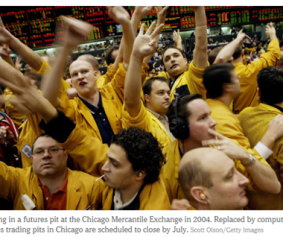Silence Falls On Chicago’s Futures Trading Pits
Monday, March 30th, 2015 @ 3:02PM
Gary D Halbert
Between the Lines
When I finished my Master’s degree in international business (Thunderbird), I went to work as a grain merchandiser for Continental Grain Company. As such, I bought and sold grain (corn, wheat, soybeans, etc.) all across Texas, Oklahoma, Kansas, Louisiana, New Mexico, etc. Those purchases and sales had to be hedged on the futures markets in Chicago, so I became a hedging specialist.
During those years in the late 1970s, I made dozens of trips to Chicago and I always made a point to spend some time on the trading floors of the bustling Chicago Board of Trade or the Chicago Mercantile Exchange, or both. For better or worse, those trading floors are like ghost towns today and will be closing forever this summer. It is the end of an era.
William Alden writing in The New York Times yesterday tells the story of the rise and fall of the futures trading pits as well or better than I could:
“The pits where generations of sweating traders in colorful jackets once bellowed out orders for wheat, corn and cattle contracts, using hand signals and sheer force of personality, are almost empty. The smattering of traders who hung around them on a recent day appeared listless, some glancing at tablet screens, others staring blankly into space.
Open-outcry futures trading, a profession that took root here [Chicago] in the mid-19th century, becoming part of the city’s identity and influencing trading systems around the world, is going extinct. Most of the futures pits inside the Chicago Board of Trade building, an Art Deco tower that looms over downtown’s LaSalle Street, are scheduled to close by July after being choked by a decade of technological advancement that has made face-to-face trading largely obsolete…
But the official end of the commodity futures pits this summer — including those in New York, where metals and energy contracts are traded — will nevertheless amount to a loss. Gone will be the trading-floor culture that was captured in the 1983 film “Trading Places” and provided the backdrop for a memorable scene in “Ferris Bueller’s Day Off.” Gone will be the feverish habitat where a lexicon of hand gestures survived through the decades and only occasionally devolved into fisticuffs.
Perhaps even more significant for Chicago is the disappearance of a career path that for over 150 years allowed scrappy teenagers and former high school athletes to hustle their way to wealth, or at least excitement. Futures trading — as distinguished from options trading, its more cerebral relative — was for many years a way for those with a blue-collar background to enter the white-collar world.
“It’s no longer a way for a working-class guy with street smarts and a huge native intelligence to make a lot of money,” said Caitlin Zaloom, a cultural anthropologist at New York University who has studied futures pits. “It’s now the domain of the kinds of technical specialists who are really winners in other parts of the economy as well.”
Futures contracts — agreements to buy or sell something at a certain price in the future — were invented to protect farmers against price movements for grain. In 1848, with Chicago quickly becoming a hub for Midwestern farmers to connect with East Coast money, a group of the city’s merchants set up the Chicago Board of Trade, the first futures exchange in the United States. The Board of Trade’s archrival during the 20th century, the Chicago Mercantile Exchange, known as the Merc, which grew out of the old Chicago Butter and Egg Board, merged with it in 2007.
The system for trading futures stayed remarkably consistent. In the pit, traders shouted offers to buy and sell while keeping their eyes and ears open for other offers to jump on before making eye contact with the counterparty and then writing down the trade on a [hand-held] card.
But the technological change, when it came, happened quickly. The Merc introduced some electronic futures trading in the 1990s, and the Board of Trade opened its own system for electronically trading agricultural futures in 2006. As it became faster and often cheaper for institutions to trade online, orders to the pit began to dry up.
The monthly trading volume in soybean futures, for example, was less than 5 percent electronic in July 2006, according to exchange data collected by Mr. Irwin and Dwight R. Sanders, a professor of agribusiness economics at Southern Illinois University. Eighteen months later, the professors found, more than 80 percent of that trading volume was electronic…
These days, according to CME, open-outcry trading accounts for just 1 percent of the total trading volume in futures. The trading floor today can seem as much like a soundstage as a working exchange. Fox Business has a studio there, and Rick Santelli of CNBC broadcasts in front of the [options] pits.
In a twist, the options pits, which traders say were hardly ever as raucous as the futures pits, are now the only place on the floor where anything resembling the old level of activity can be found…”
I haven’t been back to the Board or the Merc in a number of years, so I have not witnessed first-hand their demise. All things change over time, and so it is for the open-outcry buying and selling of millions of dollars in commodities contracts a day in each trading pit.
But if you don’t mind, I will fondly remember the pits as they were when I frequented them often.
Posted by AIA Research & Editorial Staff
Categories: Between the Lines


